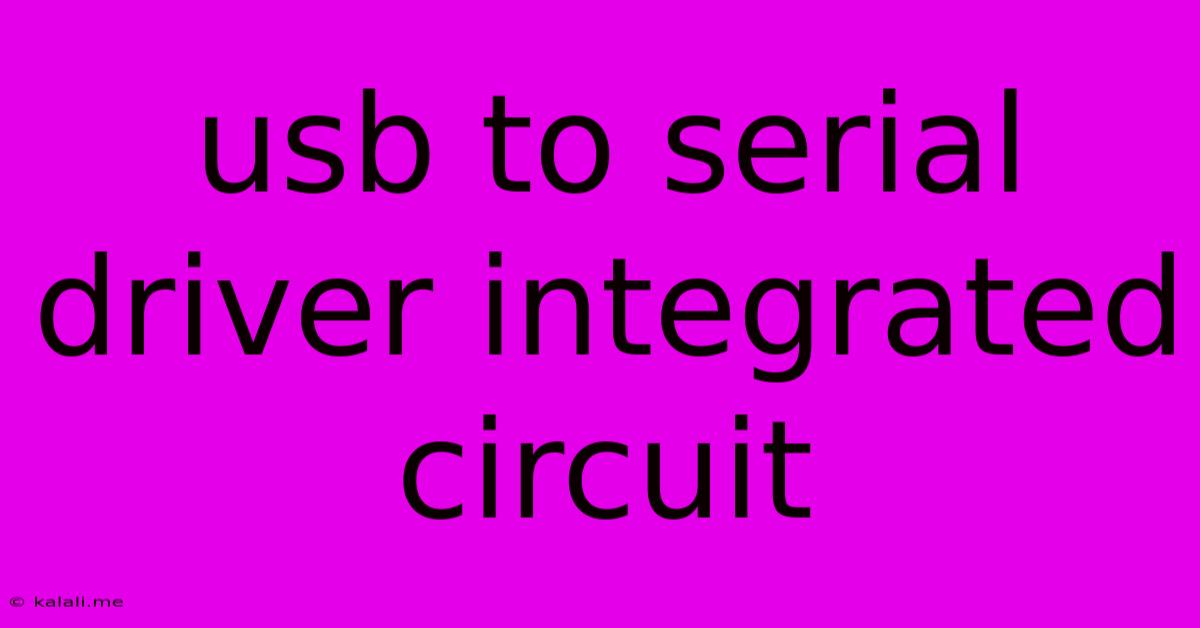Usb To Serial Driver Integrated Circuit
Kalali
May 26, 2025 · 3 min read

Table of Contents
USB to Serial Driver Integrated Circuit: A Deep Dive
Meta Description: Learn about the crucial role of integrated circuits in USB to serial communication. This article explores different ICs, their functionalities, and considerations for choosing the right one for your project. We cover key features, applications, and troubleshooting tips.
USB to serial communication is ubiquitous in various applications, from industrial automation and embedded systems to connecting older peripherals to modern computers. The heart of this conversion lies within a small but powerful component: the USB to serial driver integrated circuit (IC). This article delves into the intricacies of these chips, exploring their functionality, selection criteria, and practical applications.
Understanding the Role of the IC
A USB to serial IC acts as a bridge, translating data between the USB protocol used by your computer and the serial communication protocol (typically RS-232, RS-485, or TTL) used by many devices. This conversion involves several complex processes, including:
- USB protocol handling: Managing communication with the USB host controller, including data transfers and power management.
- Serial communication management: Controlling the transmission and reception of serial data, adhering to the specific serial standard (baud rate, data bits, parity, etc.).
- Voltage level conversion: Converting the USB voltage levels to the appropriate voltage levels for the serial port. This is crucial as USB and serial ports often operate at different voltage levels.
- Signal conditioning: Ensuring clean and reliable data transmission by handling noise and signal integrity issues.
Popular USB to Serial ICs and Their Features
Several manufacturers produce USB to serial ICs, each with unique features and capabilities. While specific models vary widely, common features include:
- Data transfer rates: Varying from low speeds suitable for simple data logging to high speeds for demanding applications. Look for specifications highlighting Mbps (Megabits per second) capabilities.
- Support for different serial standards: Many support RS-232, RS-485, and TTL serial communication. This flexibility is essential for compatibility with various devices.
- Power consumption: An important consideration for battery-powered applications. Low power consumption is a desirable feature.
- Built-in features: Some ICs include additional features like flow control (RTS/CTS), break signals, and multiple serial ports.
- Operating temperature range: Essential for applications in harsh environments. Check the specification for the operating temperature range to ensure suitability.
Choosing the Right IC for Your Project
Selecting the appropriate USB to serial IC depends heavily on your specific application requirements. Consider the following factors:
- Data rate requirements: Determine the maximum data transfer rate needed for your application.
- Serial communication standard: Identify the serial protocol used by the device you're connecting.
- Power consumption limitations: If your application is battery-powered, power consumption is a critical factor.
- Environmental conditions: If operating in extreme temperatures or other harsh environments, the IC's operating temperature range must be suitable.
- Cost and availability: Balance performance and features with budget considerations and component availability.
Troubleshooting Common Issues
When working with USB to serial ICs, several common issues might arise:
- No communication: Check all connections, verify the correct baud rate, and ensure the driver is correctly installed.
- Data corruption: Check for noise or signal integrity problems. Consider using shielded cables and appropriate signal conditioning techniques.
- Power supply issues: Ensure the IC receives adequate and stable power.
Understanding the intricacies of USB to serial driver integrated circuits is crucial for successful project implementation. By carefully considering the factors discussed above and selecting the right component, you can ensure reliable and efficient communication between your USB devices and serial peripherals. Remember to consult the datasheet of your chosen IC for detailed specifications and application information.
Latest Posts
Latest Posts
-
It Was A Pleasure Speaking With You
May 27, 2025
-
Why Do British Singers Sound American
May 27, 2025
-
Where Was Jesus When Lazarus Died
May 27, 2025
-
Was Peter In The Bible Married
May 27, 2025
-
Is Momentum Conserved If A Spring Is In The Collision
May 27, 2025
Related Post
Thank you for visiting our website which covers about Usb To Serial Driver Integrated Circuit . We hope the information provided has been useful to you. Feel free to contact us if you have any questions or need further assistance. See you next time and don't miss to bookmark.